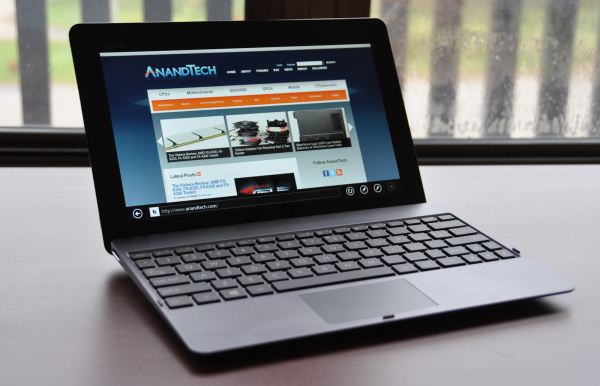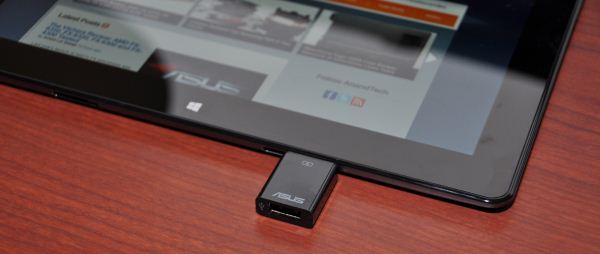ASUS VivoTab RT Review
by Vivek Gowri on October 23, 2012 3:01 PM EST- Posted in
- Asus
- Mobile
- Tablets
- Windows RT
- Vivo Tab
The ASUS Transformer line of tablets have consistently been among the strongest contenders in the Android tablet world, so when it was announced that they would be one of the launch partners for Microsoft’s Windows-on-ARM push, big things were expected. And so we have the ASUS VivoTab RT. The VivoTab name comes from the Latin verb “to live”, while the RT part is of course an indication of Windows RT, the official name for the ARM version of Windows. Windows RT-based tablets are Microsoft’s first real competitors built for the modern tablet market, so this is a hugely important launch for Microsoft as well as its hardware partners. Obviously the elephant in the room here is Surface and how Microsoft entering the hardware market changes the Windows 8/RT launch, but we’ll get to that part in time.
The division of Windows 8 (x86) and Windows RT (ARM) has resulted in a whole host of tablets with names ending in RT, and very similarly named examples running the x86-based Windows 8, so it’s worth keeping track of. For example, the VivoTab is x86-based, with Windows 8, Clover Trail, and an 11.6” display, a completely different product than the VivoTab RT that we have in front of us today. The RT is very important in making the distinction between ARM and x86 hardware platforms.
At first glance, the VivoTab RT looks pretty similar to what we’re used to seeing from the Transformer line, with a 10.1” IPS 768p display housed in a slim aluminum chassis and Nvidia’s Tegra 3 silicon underhood. The specsheet is actually pretty similar to the original Transformer Prime from last December, sharing identical width and thickness dimensions in addition to the obvious hardware-level similarities. The Transformer tablets have all been either 1280x800 or 1920x1200, so the switch to a 16:9 screen has allowed ASUS to make the VivoTab RT a bit shorter, as well as 60g lighter, than the Transformer Prime. At 1.15lbs, the VivoTab RT is quite the featherweight, helped along in this by the nano molding technology that injects liquid plastic to fuse the aluminum frame with the plastic components.
| Tablet Specification Comparison | ||||||
| ASUS VivoTab RT | Microsoft Surface for Windows RT | ASUS Eee Pad Transformer Prime | ASUS Transformer Pad Infinity | |||
| Dimensions | 263mm x 171mm x 8.3mm | 275 x 172 x 9.4mm | 263 x 180.8 x 8.3mm | 263 x 180.6 x 8.4mm | ||
| Chassis | Aluminum + Plastic | Magnesium | Aluminum | Aluminum + Plastic | ||
| Display | 10.1-inch 1366 x 768 Super IPS+ | 10.6-inch 1366 x 768 | 10.1-inch 1280 x 800 Super IPS+ | 10.1-inch 1920 x 1200 Super IPS+ | ||
| Weight | 525g | 680g | 586g | 594g | ||
| Processor | 1.3GHz NVIDIA Tegra 3 (T30 - 4 x Cortex A9 |
1.3GHz NVIDIA Tegra 3 (T30 - 4 x Cortex A9 |
1.3GHz NVIDIA Tegra 3 (T30 - 4 x Cortex A9) |
1.6GHz NVIDIA Tegra 3 (T33 - 4 x Cortex A9) |
||
| Memory | 2GB | 2GB | 1GB | 1GB DDR3-1600 | ||
| Storage | 32/64GB + microSD slot | 32/64GB + microSD slot | 32GB/64GB + microSD slot | 32/64GB + microSD slot | ||
| Battery | 24.4Whr | 31.5Whr | 25Whr | 25Whr | ||
| Pricing | $599/699 (includes dock) | $499/599 | $499/$599 | $499/$599 | ||
The heart of the VivoTab RT is a 1.3GHz T30, the same chip as the Transformer Prime and international HTC One X, amongst other devices. It’s paired with 2GB of DDR3L memory, 32GB of NAND storage, 2.4GHz 802.11n, Bluetooth 4.0, cameras front (2MP) and back (8MP with an LED flash and 1080p video), a 10.1” 1366x768 Super IPS+ panel, and a 25Wh battery. In addition, it has a microSD card slot, a micro-HDMI port, and the proprietary charging/dock connector. The port itself is different from the ones on the Transformers, the VivoTab RT uses a smaller and lower-profile connector. Included in the box is a USB 2.0 dongle that connects up to the dock connector. It’s a bit unwieldy, but it’s better than not having any options for USB support.
When the VivoTab RT went up for preorder, it was priced at $599/699 for the 32GB and 64GB versions, respectively, with various online retailers offering a pre-order bundle with the 32GB VivoTab RT and the laptop dock together for $749. Shortly before this review went live, however, I received an email from ASUS saying that final pricing would be $599 for the 32GB model including the docking station, with most of the focus being on selling the bundle rather than the individual pieces. This was likely a response to the more aggressive pricing of the Surface RT, which offers similar hardware for $499 (32GB), or $599 when bundled with the Touch Cover keyboard case. It’s good to see ASUS adjust to Microsoft’s pricing this quickly, but I’m not sure there was much of a choice there if they wanted to be competitive. The laptop dock is more functional than Microsoft’s keyboard covers and throws in a near-doubling of battery capacity for good measure, so the new pricing quickly turns the VivoTab RT into a good value.












68 Comments
View All Comments
AahzNotOz - Tuesday, October 23, 2012 - link
One thing I haven't seen discussed about RT is will it play the Windows extracted Digital Copy movies you sometimes get with Blu-Ray? I know Win 8 Pro slates should be able to play them fine, but how about Win RT?KineticHummus - Tuesday, October 23, 2012 - link
Hopefully this thing can play back high profile H264 like what most people use for MKV's! I'd love to be able to take some 720p anime on the bus with me. None of the 10 inch android tablets are too interesting to me, and the nexus 7 is too small. The iPad is out of the question, it cant play my files.Urizane - Tuesday, October 23, 2012 - link
High profile H.264 in an MP4 container on an iPad...sure. I'm guessing you're just not thrilled about burning in subtitles. As far as Windows RT goes...I'm guessing MKV support is going to have to come by way of a "Modern UI" (Metro) app playing MKVs back in software (slow) rather than through the hardware accelerator. I only say that, because messing with the core components (e.g. adding a DirectShow filter) is probably not allowed out of the box, and any .AX file would have to be compiled for Windows on an ARM CPU anyway. In such a case, you're still better off with H.264 in an MP4 container, because that's guaranteed to work. The same tricks used on Windows 7 for hardware playback of MKV streams should still work in Windows 8 Pro. You might need to lean in that direction if you have a complete aversion to demuxing your MKVs and muxing them into MP4s.frozentundra123456 - Tuesday, October 23, 2012 - link
Sorry, but I guess I am not that familiar with Win RT. What can you really do on Win RT? I mean if it doesnt run x86 apps, does it run android apps, or just apps from the microsoft store?It seems like kind of in limbo to me. TBH, I really hate Android. Hundred, thousands, whatever of apps, but I have yet to find any that are useful and work well. The few useful apps that I have tried tend to have some fatal flaw such as being frustratingly slow, locking up. crashing, etc.
So if you cant run x86 apps, how is this an improvement?
Roland00Address - Wednesday, October 24, 2012 - link
When Windows RT launches there is going to be about 3000 apps in the Microsoft store.This will change with time, remember if an app is developed for the Microsoft store it will work on windows rt or windows 8 regardless of the processor in use.
Windows 7 phones launched with about 2,000 apps, it had 20,000 apps 6 months later, 40,000 apps 12 months later, and now has over a 100,000 apps.
You are going to see a similar or faster app development for windows 8 for the fact more people are going to use windows 8 then you are going to see people using windows 7 phone.
horibatech - Tuesday, October 23, 2012 - link
I dont know if it just because I have heard you talk on the podcast, but I love the 'tone' if your review. All the Anandech respectability with some Vivek flair. It's up to you, Anand, and the comments section, but I for one appreciate your candor and actually putting you opinion on the line. Keep up the good work and stay on the podcast!Death666Angel - Friday, October 26, 2012 - link
I think I'll wait until 2013 with new ARM and Intel architectures. Just feels like it is "too early" for IVB/CortexA9 Win8/RT. Haswell and A15 should do much to help with performance/battery life.BlueInAtlanta - Monday, December 31, 2012 - link
This device is the opposite of sleek. There's just too much machine around the edges and looks outdated. Still, I use it to sketch design ideas for my graphic design firm here in San Francisco. The tablet's nice display and its compatibility with AT&T's 4G LTE make it a very competitive model despite the looks.